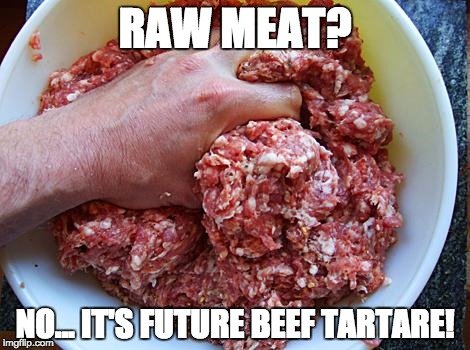Table of Contents (click to expand)
If a meat has a lot of pathogens that can infect humans, it’s probably not safe to eat that meat raw.
Imagine you are in your favorite sushi bar. The tea has been poured, the seaweed salad has been eaten, and you are now eagerly awaiting your sushi platter. When it finally arrives, you see pink fat marbled salmon sitting atop the perfectly shaped rice, and your mouth begins to water.
Now, if you’re at a fried chicken joint, and you see pink meat when you bite into your chicken leg, you’ll probably have more than a few complaints. In any restaurant, raw food could be the difference between success and failure.
So why is it okay to eat raw fish and not raw chicken, beef, or pork? Many even shy away from raw eggs.
Short answer: Raw meat from certain animals, such as fish, contain fewer pathogens – bacteria, viruses, and parasites – that can infect humans. Eating raw meat depends on several factors, including preparation, hygiene conditions, the source of the meat, and the species of the animal.
Which Meats Can You Eat Raw?
While some people are incredibly paranoid about undercooked food, there is actually a range of meat you can eat raw.
Steak tartare, a popular dish in some European countries, is raw minced beef or horsemeat flavored with spices and vegetables. Restaurants serving the dish use only the highest quality beef (think of Wagyu beef) from a few select butchers. It is also essential that the meat is fresh. Meat that is a few days old is the perfect breeding ground for pathogens to develop and multiply.
What about rare steak? The inside of the beef is minimally cooked, in “rare” cases, with only the outside getting a char. Raw beef contains pathogens on its surface, but many parasites do not penetrate the dense meat. So once the outside is cooked, a rare steak perfectly safe to eat, at least in most cases.
Fish is a great raw option for those who can’t bear the idea of waiting for something to cook. Sashimi and sushi restaurants are wildly popular worldwide, and most people don’t bat an eye at eating raw fish.
Most fish are caught in cold waters and then frozen before being served. On the off chance that there are parasites in the fish, they are killed during this process.
There is also a huge difference, evolutionarily speaking, between fish and mammals, and far fewer pathogens can “cross over”.
Finally, the fish you buy is usually not minced, which is common with beef, chicken, and pork. This means that an infected fish cannot infect other fish.

Also Read: Is Pet Food Fit For Human Consumption?
Which Meats Can’t Be Eaten Raw And Why?
Beef is on this list. Raw beef is a delicacy and, like all delicacies, is rare and expensive. Cuts of beef that most of us can afford can be infected with a few problematic pathogens.
One such pathogen is beef tapeworm, which causes almost 45 million cases worldwide each year, and is caused by eating the raw or undercooked meat. Another is Toxoplasma gondii. This parasite spreads through cat feces into other animal’s muscles, where it lies dormant, waiting to end up in a cat to complete its life cycle. However, in the absence of a cat’s stomach, humans may also be infected.

Raw pork isn’t something you hear about too often, but that’s more because raw pork doesn’t taste as great as cooked pork.
But, pork has its share of the pathogen. Trichinosis, a parasitic infection of the tissue, as well as worm cysts, infects pigs. Pigs who grow up in pens and don’t have access to a normal omnivorous diet pose a high risk of contracting pathogens that can infect humans. This is concerning since pork is one of the most widely consumed meats in the world.
The thought of raw chicken turns people’s stomachs, conjuring up the word Salmonella and the violent gut troubles Salmonella can cause. Chickens tend to harbor a large amount of Salmonella and E. coli, particularly when kept caged without access to their normal diet. However, some believe that properly pastured, healthy chickens can be eaten raw, but even so, few people forego a perfectly cooked piece of chicken for a slippery raw breast.
Also Read: Can A Microwave Kill Bacteria And Germs?
How Do You Know Meat Is Safe To Eat Raw?
There is no black and white answer to the question of whether or not you should eat raw meat. There are several factors to consider, such as how the meat is prepared, where it comes from, and under what conditions the animal was raised.
Even when it comes to sushi, fish that has been defrosted and then refrozen isn’t the best option. Sushi tastes best and is safest to eat when the fish is fresh or at least not more than 2-3 days old. Don’t worry… there are many delicious and reputable sushi spots out there!
When it comes to beef, the aim is to ensure that cows are not reared in cramped conditions and forced to eat grain from troughs their whole life. Terms such as free-range and organic have become somewhat misleading in recent years, as the definition of these terms is subjective.
Look out for grass-fed beef for all your raw beef needs. Cows have evolved to digest every nutrient available in the grass, but the same is not true for grain. A strong, grass-fed cow that spent its days in a pasture will have a healthy immune system and pose little threat to people who choose to eat its meat raw. So, not like these guys…
With poultry, you want to find chickens that have been “pastured” which is basically the same as grass-fed. This means that they have enjoyed their proper diet of insects and grubs (they’re omnivores, after all), rather than purely chicken feed. This gives them a strong immune system, which they won’t have if they are on a purely “vegetarian” diet.
With this being said, there is evidence that even grass-fed and pastured chickens are not completely free of pathogens. In fact, one study found that pastured chickens are at an increased risk of contracting pathogens. It seems that increased interaction with microbes from the soil and environment may increase the risk of contracting certain pathogens. Nevertheless, these meats are superior, and if bought fresh and from a high-quality vendor, they should be safe.
Pork is something few people would eat raw, as taste and texture improve significantly when it’s cooked. Given the conditions in which so many pigs live and how few are allowed to roam freely and eat their preferred diet, it is best to avoid trichinosis and keep your bacon cooked!
In short, you can potentially trust raw meat from farms and distributors that employ humane and sustainable methods of raising their animals, but remember, there is always a certain amount of risk with raw meat, so choose wisely!
Do you remember which meats you can eat raw?

References (click to expand)
- Northrop-Clewes, C. A., & Shaw, C. (2000, January 1). Parasites. British Medical Bulletin. Oxford University Press (OUP).
- (1985) Microbial Pathogens in Raw Pork, Chicken, and Beef - JSTOR. JSTOR
- You Asked: Why Can't I Eat Raw Meat? - TIME. Time
- Nawa, Y., Hatz, C., & Blum, J. (2005, November 1). Sushi Delights and Parasites: The Risk of Fishborne and Foodborne Parasitic Zoonoses in Asia. Clinical Infectious Diseases. Oxford University Press (OUP).
- Djurković-Djaković, O., Bobić, B., Nikolić, A., Klun, I., & Dupouy-Camet, J. (2013, July). Pork as a source of human parasitic infection. Clinical Microbiology and Infection. Elsevier BV.
- Li, Y., Carrillo, J. A., Ding, Y., He, Y., Zhao, C., Liu, J., … Song, J. (2015, September 14). Transcriptomic Profiling of Spleen in Grass-Fed and Grain-Fed Angus Cattle. (S. D. Fugmann, Ed.), Plos One. Public Library of Science (PLoS).
- Power, A. G., & Mitchell, C. E. (2004, November). Pathogen Spillover in Disease Epidemics. The American Naturalist. University of Chicago Press.
- NC DAILEY. i The Chicken or the Egg? Hen Health and Food Safety on .... ucanr.edu
